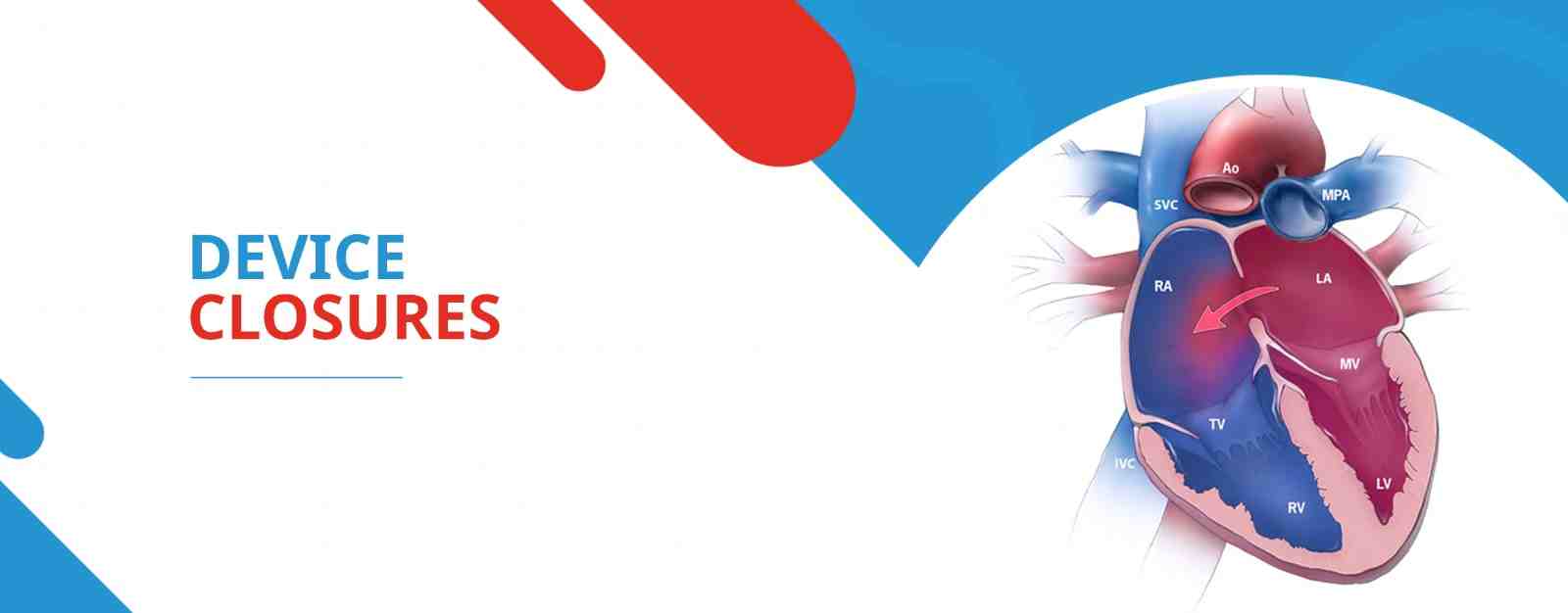
Device Closure
At Soham Heart Clinic, we are committed to providing cutting-edge cardiovascular interventions to ensure the health and well-being of our patients. Dr. Somnath Mallakmir specializes in a range of interventional cardiology procedures aimed at improving the quality of life for individuals with heart conditions. One of the exceptional services we offer is “Device Closures.”
Device Closures: Pioneering Solutions for Structural Heart Issues
Device closures have revolutionized the treatment landscape for structural heart issues, offering minimally invasive alternatives to traditional open-heart surgeries. This advanced technique involves the use of specialized devices to repair or close abnormal openings in the heart, such as atrial septal defects (ASDs), patent foramen ovales (PFOs), and ventricular septal defects (VSDs). Dr. Somnath Mallakmir is proficient in performing device closures with precision and expertise.
Benefits of Device Closures
Device closures are an integral part of our comprehensive cardiovascular care, providing a range of remarkable benefits for patients with structural heart issues. Here are some of the advantages you can expect when choosing device closures.
- Minimally Invasive Approach
- Quicker Recovery
- Reduced Scarring
- Lower Risk of Infection
- Customized Treatment
- Shorter Hospital Stay
- Improved Quality of Life
- Enhanced Cosmetic OutcomeLong-Term Success
Why Device closures is used?
Device closures are used to treat certain types of structural heart defects without the need for open-heart surgery. These defects involve abnormal openings between the chambers of the heart or the blood vessels that can disrupt the normal flow of blood or oxygen-rich blood. Device closure procedures offer a minimally invasive alternative to traditional surgical approaches, resulting in faster recovery times, reduced scarring, and shorter hospital stays.

Here are some common reasons why device closures are used:
Atrial Septal Defect (ASD) Closure:
- ASDs are abnormal openings between the atria (upper chambers) of the heart.
- Device closure is employed to seal these openings, preventing the flow of oxygen-rich blood from mixing with oxygen-poor blood.
- This procedure helps reduce strain on the heart and lowers the risk of complications such as heart failure and pulmonary hypertension.
PDA (Patent Ductus Arteriosus) Closure –
- PDA device closure is a minimally invasive medical procedure used to treat a congenital heart defect known as Patent Ductus Arteriosus (PDA).
- PDA device closure offers several advantages over traditional open-heart surgery, including Faster Recovery, Less Invasive & lower risk of complications.
Patent Foramen Ovale (PFO) Closure –
- PFOs are small openings between the atria that exist in everyone before birth but typically close shortly after.
- In some individuals, PFOs remain open, potentially allowing blood clots to pass from the right to the left side of the heart and travel to the brain, causing a stroke.
- Device closure helps reduce the risk of stroke by sealing the PFO.
Ventricular Septal Defect (VSD) Closure –
- VSDs are holes in the wall (septum) between the ventricles (lower chambers) of the heart.
- Device closure is used to close these openings, preventing the mixing of oxygen-rich and oxygen-poor blood, and reducing the workload on the heart.
Pulmonary Arteriovenous Malformation (PAVM) Closure:
- PAVMs are abnormal connections between the pulmonary artery and pulmonary veins.
- Device closure is employed to block these connections, preventing the bypass of oxygenated blood directly into the venous circulation.
Paravalvular Leak Closure:
- Paravalvular leaks can occur around artificial heart valves, causing blood to leak back into the heart chambers.
- Device closure is used to seal these leaks, improving overall valve function and reducing symptoms.
Left Atrial Appendage Closure (LAAC):
- The left atrial appendage is a small pouch in the left atrium where blood can pool and potentially form clots in patients with atrial fibrillation.
- LAAC device closure is employed to block off this pouch, reducing the risk of stroke in atrial fibrillation patients who cannot tolerate long-term blood thinners.
Vascular Malformation Closure:
- Certain vascular malformations, such as arteriovenous fistulas, can cause abnormal blood flow patterns and complications.
- Device closure is used to redirect blood flow and normalize circulation.
Innovative Alternative to Surgery:
- Device closures offer a less invasive alternative to traditional open-heart surgeries, reducing the risks associated with major surgical interventions.
- Minimally invasive procedures lead to shorter hospital stays, faster recovery times, and smaller scars.
Improved Quality of Life:
- By addressing structural heart issues through device closures, patients often experience improved heart function, reduced symptoms, and a better overall quality of life.
Prevention of Long-Term Complications –
- Device closures help prevent long-term complications associated with untreated structural heart issues, such as heart failure, arrhythmias, and stroke.
If you or a loved one are dealing with a structural heart issue, device closures could be the solution you’ve been searching for. Contact us at Soham Heart Clinic to schedule a consultation with Dr. Somnath Mallakmir, an experienced & expert interventional cardiologist and take the first step toward a healthier heart and a better quality of life.
At Soham Heart Clinic, your heart is in caring hands.
